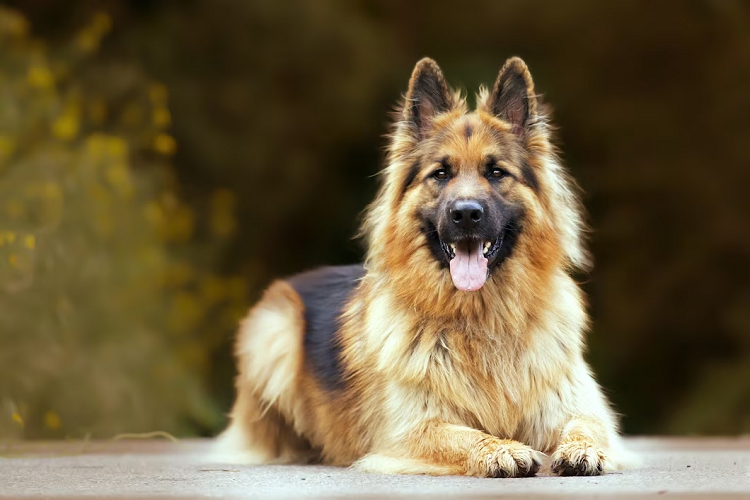German Shepherds are one of the world’s most recognizable dog breeds. Originally developed in Germany for sheep herding in the late 1800s, these bright and adaptable dogs have subsequently gained popularity in a number of tasks ranging from police and military service to household pets. These clever and devoted dogs are well-known for their muscular body, pointed ears, and powerful jaw.
10 Facts about German Shepherds
German Shepherds are a popular breed of dog, known for their intelligence, loyalty, and courage. Here are some interesting facts about German Shepherds.
Popularity
German Shepherds were first bred in Germany in the late 19th century as a herding dog. The breed was developed by Captain Max von Stephanitz, who wanted to create a dog with intelligence, strength, and agility.
German Shepherds are the second most popular breed of dog in the United States. They are also a popular breed in other countries around the world.
They are one of the most popular breeds of dog in the world and recognized by the American Kennel Club and are often used in movies and TV shows.
Most Intelligent Dog
German Shepherds are amongst the most intelligent dog breeds in the world, with the average mental capacity of a 2-year-old human child. This is due to their breeding history and genetic makeup. They were bred as working dogs and trained to shepherd livestock and defend their owner’s land, which led to them developing a fast and retentive memory that has continued into future generations. Shepherding is not as common, especially amongst pets, and so German Shepherds utilize their high intelligence to protect their household and are sometimes used as part of the police force.
Because German Shepherd dogs are intelligent and active dogs, they require a higher amount of mental stimulation to remain happy and healthy in comparison to other breeds. Otherwise, they might grow bored and indulge in harmful behaviors like chewing, digging, or excessive barking. To avoid this, you should provide your dogs with puzzle toys that will keep your German Shepherd mentally stimulated by exercising their problem-solving abilities. You should also offer your dog regular playtime and exercise like playing catch, taking walks and organizing playdates with other dog owners. You could even consider enrolling your German Shepherd into obedience lessons, where they will be mentally stimulated by being taught new commands and socializing with other dogs.
Require Regular Exercise
German Shepherds are a large and therefore highly active breed that needs frequent exercise to keep their physical and mental health in check. They have a lot of energy and need to burn it off or they may grow restless and develop behavioral issues from a lack of physical stimulation. Because of their physical capabilities, German Shepherds are a versatile breed that was originally bred for shepherding in Germany in 1899. However, these dogs have excelled in other careers since; they have been employed in the police force as detection dogs due to their agile ability, speed and their strong sense of smell.
Regular exercise is essential for keeping your German Shepherd healthy and happy. Daily walks or runs, playing in a dog-friendly and safe park, or even agility training can all be part of their regular exercise routine. Depending on the size, age and physical ability, your German Shepherd may require between 30 minutes to 2 hours of exercise a day. Walking provides your German Shepherd with a simple but effective exercise, and if done in a dog park, allows your pet to socialize with other dogs. Agility is a fun and demanding sport that gives your dog physical and mental stimulation by teaching them how to negotiate obstacles like as jumps, tunnels, and weave poles. However, be mindful that you are not overworking your dog, especially when they’re young and have not fully developed.
Lots of Hair Frequently
Whether they have short hair or long hair, German Shepherds are naturally heavy shedders. They have a double coat of fur that includes a soft undercoat and a thick outer coat which provides insulation in both cold and hot weather. However, this means your German Shepherd will shed their fur all year round, specifically in spring and autumn. Dogs shed their coat for a variety of reasons, from adapting to the changing temperatures throughout the year to protecting against health risks caused by stress, allergies, fleas and more. It takes 10 days for German Shepherds to completely shed their coat. German Shepherds are medium to heavy shedders, so expect to find dog hair in your home frequently.
Regular grooming and brushing are required to keep your German Shepherd’s coat in good condition and to avoid matting. While your dog sheds, you should brush its fur at least once a week, which will aid in removing loose hair and prevent unpleasant tangling in the dog’s coat. You should also bathe your German Shepherd on a regular basis during the shedding season, which will help remove any dirt or debris that became caught in their coat over time. To keep your home from accumulating lots of hair on floors, furniture and clothing, consider purchasing a hoover or a shedding blade to assist in keeping your property clean from frequent shedding.
Risk of Dysplasia
German Shepherds are susceptible to hip and elbow dysplasia, a hereditary disorder that compromises joint health. Hip and elbow dysplasia is a congenital disorder that involves the ball and socket of the hip or elbow joint not fitting properly, causing discomfort, agony, and even lameness. Because German Shepherds are genetically susceptible to hip and elbow dysplasia, they are at particular risk of incurring these injuries which can be quite serious; even a hip injury can begin the process of dysplasia. Symptoms could include reduced activity, trouble standing up, limping or walking by using both legs together (as in “bunny hopping”) or aggression if the hip or elbow area is touched.
Proper diet, frequent exercise, and weight management are essential in the prevention and treatment of hip and elbow dysplasia in German Shepherds. Regular vet visits can detect any problems early, and a high-quality food rich in joint-supporting ingredients like glucosamine and chondroitin can lower the likelihood of developing this ailment. Overweight German Shepherds are more likely to develop joint issues, so keeping your dog at a healthy weight is critical. Genetics also play a large role in hip and elbow dysplasia, so adopting proactive actions to preserve joint health can lower the likelihood of acquiring the illness or manage successfully. With the right care, your German Shepherd can still enjoy a healthy and happy life.
Highly Loyal Pets
German Shepherds, a breed recognized for their loyal nature, are often devoted to protecting their family and may become very territorial. In the case of an incident, such as a break-in into the home, German Shepherds are able to let out a loud and powerful bark that works as an excellent deterrent against intruders. They are also often not afraid to protect their property. Considering their agility, intelligence and protective instincts, it is no surprise that German Shepherds are utilized for security and in the police force, as their characteristics all combine to make the ideal security dog. When trained properly, they can provide bomb and drug sniffing services and even search and rescue tasks.
However, German Shepherds may become violent towards strangers or other animals they view as a threat if not properly socialized. It’s important to provide your dog with proper socialization at an early age, which can teach them to appropriately interact with others. The best method for this is to gradually introduce your German Shepherd to new people, animals and events to get them comfortable with new surroundings and prevent potential negative reactions. It is also worth considering enrolling your German Shepherd in dog training which teaches them basic commands and social skills through interacting with other dogs. Training and positive reinforcement approaches can help your German Shepherd learn to regulate their protective impulses and act correctly in a variety of circumstances.
Sensitive to Noise
Due to their genetic predisposition, German Shepherds can be very sensitive to loud noises, which may make them anxious, uncomfortable or fearful in overstimulating or strange surroundings. It is important to create a secure safe space where they may withdraw during stressful events to help them feel comfortable. This might include a crate or a quiet room in your house with a comfy bed, toys, soothing music or white noise to help filter out any loud commotion. Additionally, during times of worry or anxiety, provide enough positive reinforcement and reassurance to assist your German Shepherd so that they are able to associate these situations with positive experiences.
It’s vital to be patient, supportive and encouraging while your German Shepherd adjusts to new situations to better help them cope. This involves giving sweets or toys as a reward for good behavior and avoiding punishment or negative reinforcement, which can intensify fear and anxiety. With time and consistency, your German Shepherd may grow more resilient and adaptive, allowing them to flourish in a variety of circumstances. By creating a secure and supportive environment for your dog, you may help them feel more at ease and confident in their surroundings, establishing a greater link between you and your German Shepherd.
Suffer from Separation Anxiety
Like many dogs, German Shepherds are very social pets that can develop separation anxiety when left alone for extended periods of time. This might result in numerous, prevalent behavioral issues for your dog, including destructive tendencies, persistent barking, bladder control problems and attempting to leave the home with you. To prevent separation anxiety, provide your German Shepherd with plenty of attention and mental stimulation. Consider cage training or hiring a pet sitter or dog walker to help them get through the day. Interactive toys and puzzle feeders can also keep their minds occupied and prevent boredom.
It is best to gradually acclimatize your German Shepherd to being alone, starting with short durations and progressively extending the time for how long you’re gone. Create a consistent pattern surrounding leaving and coming home, which will familiarize your dog with your daily routine. You should also minimize your dog’s excitement by remaining calm when leaving or returning to your pet. Consider leaving a piece of worn clothing with your dog; the scent will provide comfort and ease their anxiety. By adopting these actions, you may make your German Shepherd feel more at ease and safe while you’re not there, minimizing separation anxiety and increasing their general well-being.
The Largest Dog Breeds
With an average height of 65cm, the adult German Shepherd is a large breed of dog known with a lifespan typically ranging from 9-13 years. However, various factors can affect their overall health and longevity. Investing in your dog’s health early on might assist to avoid or detect any health concerns before they worsen. Proper care is essential for them to have a long and healthy life. A healthy lifestyle for your dog that includes regular exercise, a high-quality diet, and preventative healthcare can assist to enhance lifespan.
To ensure your German Shepherd remains healthy throughout their life, schedule frequent vet check-ups or follow a preventative care program which will detect any health issues early on. This includes immunizations, parasite prevention, and regular bloodwork. Maintaining your German Shepherd’s appearance through regular grooming can also prevent health issues. Brushing, cleaning and trimming your dog’s coat helps to keep them clean of dirt, fleas and parasites as well as prevent matting, which can cause irritations and sores on your dog.
Have a Natural Prey Drive
German Shepherds have a natural desire or instinct to hunt and run after tiny creatures. This is known as the prey drive, and households potentially considering owning a German Shepherd should be aware of if they are thinking about adding this type of dog breed to their home. However, it is important to understand that this is not hostile behavior or purposefully aggressive, but rather a natural tendency developed in the breed over many generations. This is linked to their origins of being bred to shepherd livestock in farmland, and as such, German Shepherds need to be socialized to coexist with smaller dogs and other pets such as cats or rabbits.
To keep your German Shepherd from running after tiny animals, introduce them to other pets gradually in a supervised setting and never leave them unaccompanied with smaller pets until you are confident they can be trusted. Furthermore, offering lots of exercise and mental stimulation to your German Shepherd might help prevent them from utilizing their hunting drive into destructive behavior. Activities consisting of agility training, obedience lessons, and puzzle toys help keep their minds engaged, making them less likely to display negative prey-drive behavior.
Conclusion
German Shepherds are a fascinating breed with a long history and distinct physical traits. Originally developed as herding dogs, they have evolved into adaptable working dogs, excelling in a variety of professions like police work, search and rescue, and support for families and persons with disabilities. Their popularity across the world is a tribute to their intellect, devotion, and adaptability.
As with any breed, prospective owners should undergo their own research to ensure they are prepared for the responsibilities of having a German Shepherd. These dogs may make terrific friends and valuable members of any family with adequate training, socialization, and care.
K9 Patrol is one of the UK’s leading canine security companies, specialising in security risk management including security dog services for businesses, festivals and events.




